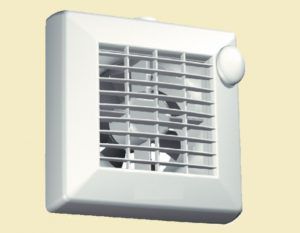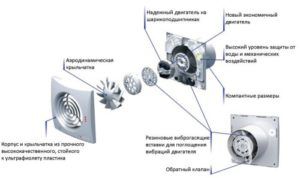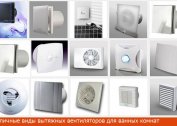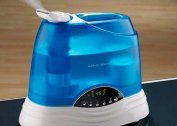Each modern apartment has its own ventilation system, which ensures the removal of exhaust air from the home and the simultaneous supply of fresh air. Over time, the ventilation system channels become clogged and air cannot move there independently. To return to normal air exchange in this case, you can install an exhaust fan in the kitchen.
The importance of having good ventilation
Unlike the rest of the home, in the kitchen, in addition to various odors, the air mixture is also saturated with excess moisture and various combustion products. This not only worsens the comfort of staying there, but also leads to fogging of the windows, the walls can be covered with an unpleasant coating.
If it is not possible to provide regular natural ventilation, the only option to ensure that clean air enters the room is to use a fan in the kitchen.
When choosing such a technique, it is necessary to carefully select its performance. Too high a reserve of power can lead to noticeable drafts, but its lack will not make it possible to ensure normal air exchange.
Varieties of fans
Nowadays, the market offers a fairly wide selection of kitchen exhaust fans, all of them are divided into three categories:
- channel;
- window;
- wall mounted.
The fan for the channel-type kitchen is installed directly inside the duct, it is hidden by the usual laid-on grille. This type of kitchen fan is distinguished by a rather high efficiency.
Window fans are rarely used these days. They are usually installed on outdated wooden windows. In the case of new plastic double-glazed windows, it will be necessary to order the manufacture of a special frame design taking into account that a fan will be installed in it. However, in such a case, the exhaust device will provide a fairly effective outlet of the exhaust air from the room. To prevent the entry of cold air into the kitchen in winter, you will also need to install a check valve.
The wall fan for the kitchen is designed for installation on openings of round or rectangular shape. Typically, such models are equipped with automation, which provides independent power management of the device, which makes it possible to significantly save energy.
Fan designs
Exhaust fans designed for use in the kitchen, according to their design, are divided into three varieties:
- axial or axial exhaust structures, which are most often found today. They are distinguished by ease of installation, compactness and power, which is quite enough for use in the kitchen;
- radial or centrifugal, which are used mainly in industrial premises, since they have a rather bulky design;
- diametrical, most often used in restaurants and cafes, where several plates work simultaneously. Differ in high power and overall performance.
Selection tips
To purchase a high-quality fan in the kitchen, which can effectively cope with its functions, when choosing it, you should pay attention to its most important parameters, choosing them in accordance with your requirements.
Performance level
According to all standards, the exhaust system in the kitchen should have a capacity that is about 10 times the volume of the room.So that the device does not constantly work at the limit of its capabilities, it is also worth adding 30% of the performance margin. This is how the necessary power of the kitchen exhaust fan should be selected.
If the goal of acquiring such equipment is simply to slightly improve the existing ventilation, then you need to choose low-power, inexpensive models.
Noisiness at work
From the point of view of this parameter, it is best to choose such fans in the kitchen, which during operation “make noise” by a maximum of 30 dB, which is only slightly higher than the usual whisper of a person. In this case, a working appliance will never cause any discomfort to those who are in the kitchen. A similar technique usually has an engine whose power does not exceed 36 watts.
If the kitchen is part of the living room, then it is most advisable to choose slow-moving models that almost do not create noticeable noise during operation.
Terms of Use
Since the air mixture in the kitchen is often quite noticeably heated, the kitchen fan must be provided with the possibility of use at high temperatures. It is especially important to pay attention to this property in the case when this device will be installed directly above the stove or in the immediate vicinity of it.
Such devices for normal functioning during the production process are coated with special compounds or a film having excellent heat-resistant properties. If they are absent, the fan, of course, will not begin to melt during operation, but the characteristic smell of burnt plastic may become noticeable.
Additional features
A significant part of the models of such air-cleaning equipment can hardly be called ordinary fans, since manufacturers are equipped with a large number of additional features. Among them:
- filter nets designed to trap fat particles from the air;
- controllers of the presence of a person in the room;
- timers that you can configure as you wish.
Whether such functions are needed in a conventional kitchen fan is for everyone to decide. It is worth noting that any additional options in this technique increase not only the convenience of its use, but also the cost of the devices.
Mounting Features
If necessary, install a conventional kitchen fan, you can do everything yourself, given some of the nuances of this work:
- For maximum functionality and efficiency of the exhaust fan, the hole for its installation should be as high as possible, under the ceiling.
- If the device’s case is round and the duct’s hole is rectangular, there is a special adapter for combining them, which sometimes comes directly with the unit, and it can also be purchased separately.
- It is easiest to feed equipment from a lighting point located nearby. In this case, the wire that provides power must be hidden in a plastic gutter.
The functionality of the device will significantly improve if a small supply valve is installed in the window frame in the kitchen. Its presence will ensure the receipt of fresh air flow from the street instead of the exhaust air removed by the fan.
Thus, installing an exhaust fan in the kitchen is a great opportunity to quickly remove exhaust air mixture from the room along with odors even without the use of an extractor fan. This is achieved by improving the functioning of the ventilation duct.





